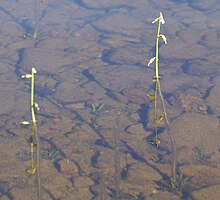| Lobelia dortmanna | |
|---|---|

| |
| Plants in pond habitat | |
| Scientific classification | |
| Kingdom: | Plantae |
| Clade: | Tracheophytes |
| Clade: | Angiosperms |
| Clade: | Eudicots |
| Clade: | Asterids |
| Order: | Asterales |
| Family: | Campanulaceae |
| Genus: | Lobelia |
| Species: | L. dortmanna
|
| Binomial name | |
| Lobelia dortmanna | |
Lobelia dortmanna, Dortmann's cardinalflower[2] or water lobelia, is a species of flowering plant in the bellflower family Campanulaceae. This stoloniferous herbaceous perennial aquatic plant with basal leaf-rosettes and flower stalks grows to 0.7–2 m (2.3–6.6 ft) tall. The flowers are 1–2 cm long, with a five-lobed white to pale pink or pale blue corolla, produced in groups of one to ten on an erect raceme held above the water surface. The fruit is a capsule 5–10 mm long and 3–5 mm wide, containing numerous small seeds.[3][4]
The leaves are almost cylindrical, blunt, 2.5–7.5 cm long and evergreen. They have no functional stomata.[5] It is one of several unrelated species of plants from low nutrient lakes known as isoetids, owing to their superficial similarity to Isoetes. The leaves of Lobelia dortmanna are, however, easily distinguishable from those of other isoetids in having only two air-canals (Isoetes having four and most others several) and in the presence of milky sap.[6] The plant has the unusual ability of removing carbon dioxide from the rooting zone rather than from the atmosphere.[7][8]
- ^ Maiz-Tome, L. (2016). "Lobelia dortmanna". IUCN Red List of Threatened Species. 2016: e.T167831A78457082. doi:10.2305/IUCN.UK.2016-1.RLTS.T167831A78457082.en. Retrieved 12 November 2021.
- ^ USDA, NRCS (n.d.). "Lobelia dortmanna". The PLANTS Database (plants.usda.gov). Greensboro, North Carolina: National Plant Data Team. Retrieved 22 June 2015.
- ^ BorealForest: Lobelia dortmanna Archived 23 September 2015 at the Wayback Machine
- ^ Blamey, M. & Grey-Wilson, C. (1989). Flora of Britain and Northern Europe. ISBN 0-340-40170-2
- ^ Sculthorpe, C.D. (1967). The Biology of Aquatic Vascular Plants. Reprinted 1985 Edward Arnold, by London. p. 114.
- ^ Keddy, P.A. (2010) Wetland Ecology: Principles and Conservation (2nd edition). Cambridge University Press, Cambridge, UK. p. 26
- ^ Wium-Andersen, S. (1971). Photosynthetic uptake of free CO2 by the roots of Lobelia dortmanna. Plantarum, 25, 245–8.
- ^ Pedersen, Ole; Sand-Jensen, Kaj; Revsbech, Niels Peter (1995). "Diel Pulses of O2 and CO2 in Sandy Lake Sediments Inhabited by Lobelia Dortmanna". Ecology. 76 (5): 1536–1545. Bibcode:1995Ecol...76.1536P. doi:10.2307/1938155. JSTOR 1938155.
